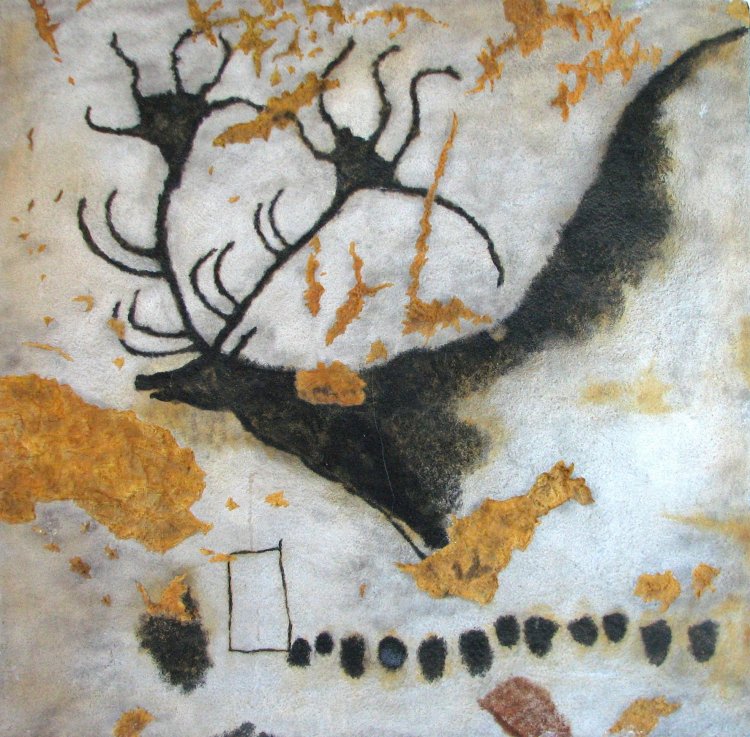On September 12, 1940, four friends were walking a dog in the hills of a French village of Montignac. They noticed a hole next to a tree struck down by a storm, decided to dig further and thus discovered an entrance to a cave. The children told their teacher of their discovery and, after a while, scientists visited the cave.
It was not that type of a cave from Mark Twain’s books, where kids could hide from their parents and indulge in fantasy. The Lascaux Cave became a true treasure of France because of thousands of parietal paintings that covered its walls. Compared to other known caves, it is small, cozy, and quite dry. No dripping stalactites and stalagmites, which explains why the paintings were preserved so well. Moreover, nature created a saline calcite layer that covered the images like varnish, protecting them from time. Gallery cave. Passageways – about 250 m long; ceilings – 30 m high; total volume – 1,500 m3.
The first scientist to explore the cave was Henri Breuil, a specialist in history of primitive society, who was in the region during the German occupation. Along with Jean Bouyssonie, André Cheynier, and then with Denis Peyrony and Henri Bégouën, he authenticated, described and examined the cave paintings. Henry Breuil called the Lascaux Cave the Versailles of cave paintings, “If Altamira is the capital of cave paintings, then the Lascaux Cave is its Versailles.” The cave was later nicknamed the Sistine Chapel of primitive painting.
What do those wall paintings depict? They are classical examples of cave painting, which scientists divided into three topical groups: animals, people, and symbols. The images are mostly painted in red, yellow and black, since those were the mineral pigments available to people at the time. The depictions of animals often include horses and deer. Interestingly, those animals appear to be moving rather than standing as we can see herds of running horses, massive bulls, bisons and even rhinoceros poised to attack, as well as graceful felines. There are no images of plants on the walls. Scientists think that the cave might have been a place of worship or a sanctuary to ancient people.
Let’s walk through the world famous cave and enjoy the images made by our ancestors. The Hall of Bulls or the Rotunda is decorated with large images of four black bulls. Some scientists believe that the animals are depicted full size. Aside from the bulls, there is a dozen horses, some deer, a bear, and an unknown animal with a horn on its forehead. In the distant past, there might have been some daylight reaching the rotunda, which would have made the paintings play beautifully. The hall leads to the entrance to the axial gallery. It is around 17 meters long, decorated with images of deer, bulls, and horses. To the right of the axial gallery is the Passage: many images there were damaged due to air circulation. The axial gallery is followed by the Nave, which leads to a corridor decorated with cats – the Chamber of Felines. Going through the axial gallery in the opposite direction, you may find the Apse and the Shaft.
The cave is even decorated in places that are hard to reach. Our ancestors had to resort to various tricks to do that, inventing devices for painting on walls and ceilings. For example, they would build ladder-like structures as scaffolding. They would put tree branches across openings in the cave, and use clay to fix them in place. All this was done to paint the ceiling and decorate the walls with enormous bulls (5 m long and 2 m tall). A curious image was found at the bottom of the shaft: a rhinoceros standing next to a fallen man, with six paired dots around them. This is not just a drawing; there is some story behind it.
At present, we don’t know the exact age of the wall paintings in the cave. They were attributed to the ancient Magdalenian culture for a long time, but recent research produced evidence that they may date back to the earlier, Solutrean culture. The indications are the geometric symbols, the depiction of aurochs horns, a man facing a cavicorn animal, and an image showing a man opposite a musk ox.
The cave paintings are not as primitive as they may seem at first. The ancient painters, like all artists, had their characteristic techniques:
- polychromy;
- shading;
- perspective;
- unpainted areas in a painting;
- distortion.
Apart from the primitive artwork, objects made by artisans were also found in the cave. For instance, a carved lamp of pink sandstone. The ancient people burned fat in it using a juniper wick. Such a lamp could light up the cave for an hour. Tools made of bone and flint stone were found as well, which was taken as a sign that the cave was not used as a dwelling, but instead was a sacred place to be decorated with cave paintings.
The primitive culture site became popular nearly overnight. The cave opened to visitors in 1948, but that had a disastrous effect. The “microflora” of the natural dwelling was damaged: bacteria and even algae started appearing on the walls as a result. In 1960, algae colonies began spreading due to excess of carbon dioxide, high temperature, and artificial lighting. Then, the environment enriched with carbon dioxide lead to calcite covering the walls and some of the primitive artwork. The cave was closed in 1963, and the next 10 years the colors and vividness of the images had undergone a thorough restoration.
On July 18, 1983, Lascaux II – the exact replica of the original cave – opened to visitors in the vicinity of the cave once found by four boys, which has since become a national treasure of France and UNESCO World Heritage Site.
The article is based on open sources.
Фото на странице и на главной странице сайта: HTO. Сфотографировано загрузившим / Общественное достояние / Wikipedia






















